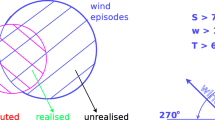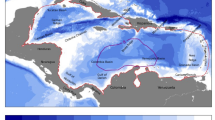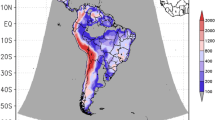Abstract
Southeast Asia (SEA) climate shows a large range of variability scales, from extreme events to interannual variability. Understanding its answer to climate change is of primary scientific and socio-economic importance. IPCC 5th assessment report however pointed the lack of knowledge in regional climate change and its impact in SEA. In particular little is known about the answer of wind to climate change. The impact of climate change on sea surface wind speed is investigated here, examining changes in daily and extreme event scales, interannual variability and climatological average between the twentieth and twenty-first centuries. For that the RegCM4 regional model was used to perform a dynamical downscaling of CMIP5 simulations done with CNRM-CM5 global climate model under RCP4.5 and RCP8.5 hypothesis. Comparisons with QuikSCAT satellite data show that the downscaled simulations perform overall better than the global simulations. Both models produce regionally and seasonally contrasted results in terms of daily wind speed answer to climate change. Global simulations produce mostly weak and non-significant changes, only suggesting an intensification of northeast winter monsoon in the northern SEA. Conversely regional downscaled simulations suggest from March to November in the northern South China Sea and Pacific regions a significant weakening of wind speed from climatological to daily scales (summer monsoon to extreme values), for regions and periods of initially strong values, associated with a 40–50% decrease of tropical cyclones frequency. These changes result from the increase of mean meridional south to north sea level pressure gradient and decrease its daily variability.



















Similar content being viewed by others
References
Ashfaq M, Shi Y, Tung W-W, Trapp RJ, Gao X, Pal JS, Diffenbaugh NS (2009) Suppression of south Asian summer monsoon precipitation in the 21st century. Geophys Res Lett 36:L01704. https://doi.org/10.1029/2008GL036500
Chotamonsak C, Salathé EP, Kreasuwan J, Chantara S, Siriwitayakorn K (2011) Projected climate change over Southeast Asia simulated using a WRF regional climate model. Sci Lett Atm. https://doi.org/10.1002/asl.313
Cruz FT, Narisma GT, Dado JB, Singhruck P, Linarka UA, Wati T, Tangang F, Juneng L, Phan-Van T, Ngo-Duc T, Santisirisomboon J, Gunawan D, Aldrian E (2017) Sensitivity of temperature to physical parameterization schemes of RegCM4 over the CORDEX-Southeast Asia Region. Int J Climatol 37:5139–5153. https://doi.org/10.1002/joc.5151
Da ND, Herrmann M, Morrow R, Niño R, Huan NM, Trinh NQ (2019) Contributions of wind, eddies, chaotic variability and ENSO to the interannual variability of the South Vietnam Upwelling. J Geophys Res. https://doi.org/10.1029/2018JC014647
Dickinson RE, Henderson-Sellers A, Kennedy PJ (1993) Biosphere-atmosphere transfer scheme (BATS) version 1E as coupled to the NCAR Community Climate ModelRep., 72pp, Natl Cent for Atmos Res, Boulder, Colorado, NCAR Tech Note
Emanuel KA, Živković-Rothman M (1999) Development and evaluation of a convection scheme for use in climate models. J Atmos Sci 56(11):1766–1782
Endo N, Matsumoto J, Lwin T (2009) Trends in precipitation extremes over Southeast Asia. SOLA 5:168–171
Fu R (2015) Global warming-accelerated drying in the tropics. Proc Natl Acad Sci 112(12):3593–3594
Giorgi F (2019) Thirty years of regional climate modeling: where are we and where are we going next? J Geophys Res Atmos. https://doi.org/10.1029/2018JD030094
Giorgi F, Bi X, Pal J (2004) Means, trends and interannual variability in a regional climate change experiment over Europe. Part I: present day climate (1961–1990). Clim Dyn 22:733–756
Giorgi F, Coppola E, Solmon F, Mariotti L, Sylla M, Bi X, Elguindi N, Diro G, Nair V, Giuliani G, Turuncoglu U, Cozzini S, Guttler I, OíBrien T, Tawfik A, Shalaby A, Zakey A, Steiner A, Stordal F, Sloan L, Brankovic C (2012) RegCM4: model description and preliminary tests over multiple CORDEX domains. Clim Res 52:7–29. https://doi.org/10.3354/cr01018
Hanafusa M, Sasaki H, Murata A, Kurihara K (2013) Projection of changes in future surface wind around japan using a non-hydrostatic regional climate model. SOLA 9:23–26. https://doi.org/10.2151/sola.2013-006
Held IM, Soden BJ (2006) Robust responses of the hydrological cycle to global warming. J Clim 19(21):5686–5699
Ho TMH, Phan VT, Le NQ, Nguyen QT (2011) Detection of extreme climatic events from observed data and projection with RegCM3 over Vietnam. Clim Res 49:87–100
Holtslag AAM, De Bruijn EIF, Pan HL (1990) A high resolution air mass transformation model for short-range weather forecasting. Mon Weather Rev 118(8):1561–1575
IPCC Climate Change (2013) The physical science basis. In: Stocker TF, Qin D, Plattner G-K, Tignor M, Allen SK, Boschung J, Nauels A, Xia Y, Bex V, Midgley PM (eds) Contribution of working group i to the fifth assessment report of the intergovernmental panel on climate change. Cambridge University Press, Cambridge, p 1535
Ito K, Kuroda T, Saito K, Wada A (2015) Forecasting a large number of tropical cyclone intensities around Japan using a high-resolution atmosphere–ocean coupled model. Weather Forecast 30:793–808. https://doi.org/10.1175/WAF-D-14-00034.1
Izumo T, Montegut C, Luo J, Behera S, Masson S, Yamagata T (2008) The role of the western Arabian Sea upwelling in Indian monsoon rainfall variability. J Clim 21(21):5603–5623
Jourdain NC, Gupta AS, Taschetto AS, Ummenhofer CC, Moise AF, Ashok K (2013) The Indo-Australian monsoon and its relationship to ENSO and IOD in reanalysis data and the CMIP3/CMIP5 simulations. Clim Dyn 41:3073–3102. https://doi.org/10.1007/s00382-013-1676-1
Juneng L, Tangang F, Chung JX, Ngai ST, The TW, Narisma G, Cruz F, Phan-Van T, Ngo-Duc T, Santisirisomboon J, Singhruck P, Gunawan D, Aldrian E (2016) Sensitivity of the Southeast Asia rainfall simulations to cumulus and ocean flux parameterization in RegCM4. Clim Res 69:59–77. https://doi.org/10.3354/cr01386
Kajikawa Y, Yasunari T, Yoshida S, Fujinami H (2012) Advanced Asian summer monsoon onset in recent decades. Geophys Res Lett 39:L03803
Kiehl JT (1996) Description of the NCAR community climate model (CCM3). Report, 152p, Boulder, Colorado: Tech. Note, NCAR/TN-420+STR
Kitoh A (2017) The Asian monsoon and its future change in climate models: a review. J Meteor Soc Japan 95:7–33. https://doi.org/10.2151/jmsj.2017-002
Lal M, Harasawa H (2001) Future climate change scenarios for Asia as inferred from selected coupled atmosphere-ocean global climate models. J Meteorol Soc Jpn 79(1):291–297. https://doi.org/10.2151/jmsj.79.219
Lau WKM, Kim K-M (2015) Robust Hadley Circulation changes and increasing global dryness due to CO2 warming from CMIP5 model projections. Proc Natl Acad Sci 112:3630–3635
Liu Y, Tang D, Evgeny M (2019) Chlorophyll concentration response to the typhoon wind-pump induced upper ocean processes considering air–sea heat exchange. Remote Sens 1825:11
Loh JL, Tangang F, Juneng L et al (2016) Projected rainfall and temperature changes over Malaysia at the end of the 21st century based on PRECIS modelling system. Asia-Pac J Atmos Sci 52:191. https://doi.org/10.1007/s13143-016-0019-7
Loo YY, Billa L, Singh A (2015) Effect of climate change on seasonal monsoon in Asia and its impact on the variability of monsoon rainfall in Southeast Asia. Geosci Front 6:817–823. https://doi.org/10.1016/j.gsf.2014.02.009
Ma J, Xie SP, Kosaka Y (2012) Mechanisms for tropical tropospheric circulation change in response to global warming. J Clim 25(8):2979–2994
Manomaiphiboon K, Octaviani M, Torsri K, Towprayoon S (2013) Projected changes in means and extremes of temperature and precipitation over Thailand under three future emissions scenarios. Clim Res 58:97–115. https://doi.org/10.3354/cr01188
Manton MJ et al (2001) Trends in extreme daily rainfall and temperature in Southeast Asia and the South Pacific: 1961–1998. Int J Climatol 21(3):269–284
Meehl GA, Arblaster JM (2002) The tropospheric biennial oscillation and Asian-Australian monsoon rainfall. J Clim 15(7):722–744
Nakicenovic N et al (2000) IPCC Special report on emissions scenarios. Cambridge University Press, Cambridge
Neale R, Slingo J (2003) The maritime continent and its role in the global climate: a GCM study. J Clim 16(5):834–848
Ngo-Duc T, Kieu C, Thatcher M, Nguyen-Le D, Phan-Van T (2014) Climate projections for Vietnam based on regional climate models. Clim Res 60:199–213. https://doi.org/10.3354/cr01234
Ngo-Duc T, Tangang FT, Santisirisomboon J, Cruz F, Trinh-Tuan L, Nguyen-Xuan T, Phan-Van T, Juneng L, Narisma G, Singhruck P, Gunawan D, Aldrian E (2017) Performance evaluation of RegCM4 in simulating Extreme Rainfall and Temperature Indices over the CORDEX-Southeast Asia Region. Int J Climatol 37:1634–1647. https://doi.org/10.1002/joc.4803
Nguyen-Le D, Matsumoto J, Ngo-Duc T (2014) Climatological onset date of summer monsoon in Vietnam. Int J Climatol 34:3237–3250. https://doi.org/10.1002/joc.3908
Pal JS, Giorgi F, Bi X, Elguindi N et al (2007) Regional climate modeling for the developing world: the ICTP RegCM3 and RegCNET. Bull Am Meteorol Soc 88:1395–1409
Pan J, Sun Y (2013) Estimate of ocean mixed layer deepening after a typhoon passage over the South China sea by using satellite data. J Phys Oceanogr 43(3):498–506. https://doi.org/10.1175/JPO-D-12-01.1
Phan VT, Long TT, Hai BH, Kieu C (2015) Seasonal forecasting of tropical cyclone activity in the coastal region of Vietnam using RegCM4.2. Clim Res 62:115–129
Raghavan SV, Vu MT, Liong SY (2017) Ensemble climate projections of mean and extreme rainfall over Vietnam. Glob Planet Change 148:96–104. https://doi.org/10.1016/j.gloplacha.2016.12.003
Raghavan SV, Liu J, Nguyen NS, Vu MT, Liong S-Y (2018) Assessment of CMIP5 historical simulations of rainfall over Southeast Asia. Theor Appl Climatol 132:989–1002. https://doi.org/10.1007/s00704-017-2111-z
Shen C, Yan Y, Zhao H, Pan J, Devlin A (2018) Influence of monsoonal winds on chlorophyll-α distribution in the Beibu Gulf. PLoS ONE 13(1):e0191051. https://doi.org/10.1371/journal.pone.0191051
Siew JH, Tangang FT, Juneng L (2014) Evaluation of CMIP5 coupled atmosphere–ocean general circulation models and projection of the Southeast Asian winter monsoon in the 21st century. Int J Climatol 34:2872–2884. https://doi.org/10.1002/joc.3880
Simmons A, Uppala S, Dee D, Kobayashi S (2007) ERA-Interim: new ECMWF reanalysis products from 1989 onwards. ECMWF Newsletter, Meteorology, vol 110, pp 25–35
Takahashi HG (2011) Long-term changes in rainfall and tropical cyclone activity over South and Southeast Asia. Adv Geosci 30:17–22
Tangang F, Supari S, Chung JX, Cruz F, Salimun E, Ngai ST, Juneng L, Santisirisomboon J, Santisirisomboon J, Ngo-Duc T, Phan-Van T, Narisma G, Singhruck P, Gunawan D, Aldrian E, Sopaheluwakan A, Nikulin G, Yang H, Remedio ARC, Sein D, Hein-Griggs D (2018) Future changes in annual precipitation extremes over Southeast Asia under global warming of 2°C. APN Sci Bull. https://doi.org/10.30852/sb.2018.436
Tangang F, Santisirisomboon J, Juneng L, Salimun E, Chung J, Supari S, Cruz F, Ngai ST, Ngo-Duc T, Singhruck P, Narisma G, Santisirisomboon J, Wongsaree W, Promjirapawat K, Sukamongkol Y, Srisawadwong R, Setsirichock D, Phan-Van T, Aldrian E, Gunawan D, Nikulin G, Yang H (2019) Projected future changes in mean precipitation over Thailand based on multi-model regional simulations of CORDEX Southeast Asia. Int J Climatol. https://doi.org/10.1002/joc.6163
Trinh-Tuan L, Matsumoto J, Tangang FT, Juneng L, Cruz F, Narisma G, Santisirisomboon J, Phan-Van T, Gunawan D, Aldrian E, Ngo-Duc T (2019) Application of quantile mapping bias correction for mid-future precipitation projections over Vietnam. SOLA 15:1–6. https://doi.org/10.2151/sola.2019-001
United Nations, Department of Economic and Social Affairs, Population Division (2017) World Population Prospects: the 2017 Revision, Key Findings and Advance Tables. ESA/P/WP/248.
Vecchi GA, Soden BJ (2007) Global warming and the weakening of the tropical circulation. J Clim 20:4316–4340. https://doi.org/10.1175/JCLI4258.1
Vecchi GA et al (2006) Weakening of tropical Pacific atmospheric circulation due to anthropogenic forcing. Nature 441(7089):73–76
Voldoire A, Sanchez-Gomez E, Salas y Mélia D, Decharme B, Cassou C, Sénési S, Valcke S, Beau I, Alias A, Chevallier M, Déqué M, Deshayes J, Douville H, Fernandez E, Madec G, Maisonnave E, Moine MP, Planton S, Saint-Martin D, Szopa S, Tyteca S, Alkama R, Belamari S, Braun A, Coquart L, Chauvin F (2011) The CNRM-CM5.1 global climate model: description and basic evaluation. Clim Dyn 40(9):2091–2121. https://doi.org/10.1007/s00382-011-1259-y.
Walsh K (1997) Objective detection of tropical cyclones in high-resolution analyses. Mon Weather Rev 125:1767–1779
Wang B, Lin H, Zhang Y, Lu MM (2002) Definition of South China Sea monsoon onset and commencement of the East Asia Summer Monsoon. J. Clim. 17:699–710
Wang B, Huang F, Wu Z, Yang J, Fu X, Kikuchi K (2009) Multi-scale climate variability of the South China Sea monsoon: a review. Dyn Atmos Ocean 47(1–3):15–37. https://doi.org/10.1016/j.dynatmoce.2008.09.004
Wu L, Wang B, Geng S (2005) Growing typhoon influence on east Asia. Geophys Res Lett 32:L18703. https://doi.org/10.1029/2005GL022937
Wyrtki K (1961) Physical oceanography of the Southeast Asian waters. La Jolla, California: The University of California, Scripps Institution of Oceanography, 1961. NAGA report, volume 2, Scientific Results of Marine Investigations of the South China Sea and the Gulf of Thailand 1959–1961
Xie S, Xie Q, Wang D, Liu W (2003) Summer upwelling in the South China Sea and its role in regional climate variations. J Geophys Res 108(C8):3261. https://doi.org/10.1029/2003JC001867
Yihui D, Chan JCL (2005) 2005: the East Asian summer monsoon: an overview. Meteorol Atmos Phys 89:117–142. https://doi.org/10.1007/s00703-005-0125-z
Yokoi S, Takayabu YN, Murakami H (2013) Attribution of projected future changes in tropical cyclone passage frequency over the Western North Pacific. J Clim 26:4096–4111. https://doi.org/10.1175/JCLI-D-12-00218.1
Zhang Z, Chan JCL, Dinh Y (2002) Characteristics, evolution and mechanisms of the summer monsoon onset over Southeast Asia. Int J Climatol 24:1461–1482
Zhu J, Shukla J (2013) The role of air–sea coupling in seasonal prediction of Asia-Pacific summer monsoon rainfall. J Clim 26:5689–5697
Zou L, Zhou T (2013) Can a regional ocean-atmosphere coupled model improve the simulations of the interannual variability of the Western North Pacific Summer Monsoon? J Clim 26:2353–2367
Acknowledgements
CNRM-CM5 outputs can be downloaded from the ESGS website (https://esgf-node.llnl.gov/projects/esgf-llnl/), information about output files are available on CNRM-GAME website (https://www.umr-cnrm.fr/cmip5/spip.php?article9). This work is a part of LOTUS international joint laboratory (lotus.usth.edu.vn) and CORDEX-SEA activities. Thanh Ngo-Duc is supported by the Vietnam National Foundation for Science and Technology Development (NAFOSTED) under Grant 105.06-2018.05.
Author information
Authors and Affiliations
Corresponding author
Additional information
Publisher's Note
Springer Nature remains neutral with regard to jurisdictional claims in published maps and institutional affiliations.
Electronic supplementary material
Below is the link to the electronic supplementary material.
Rights and permissions
About this article
Cite this article
Herrmann, M., Ngo-Duc, T. & Trinh-Tuan, L. Impact of climate change on sea surface wind in Southeast Asia, from climatological average to extreme events: results from a dynamical downscaling. Clim Dyn 54, 2101–2134 (2020). https://doi.org/10.1007/s00382-019-05103-6
Received:
Accepted:
Published:
Issue Date:
DOI: https://doi.org/10.1007/s00382-019-05103-6




